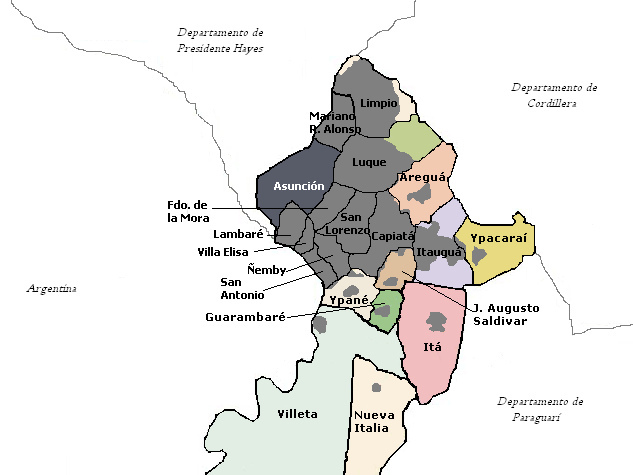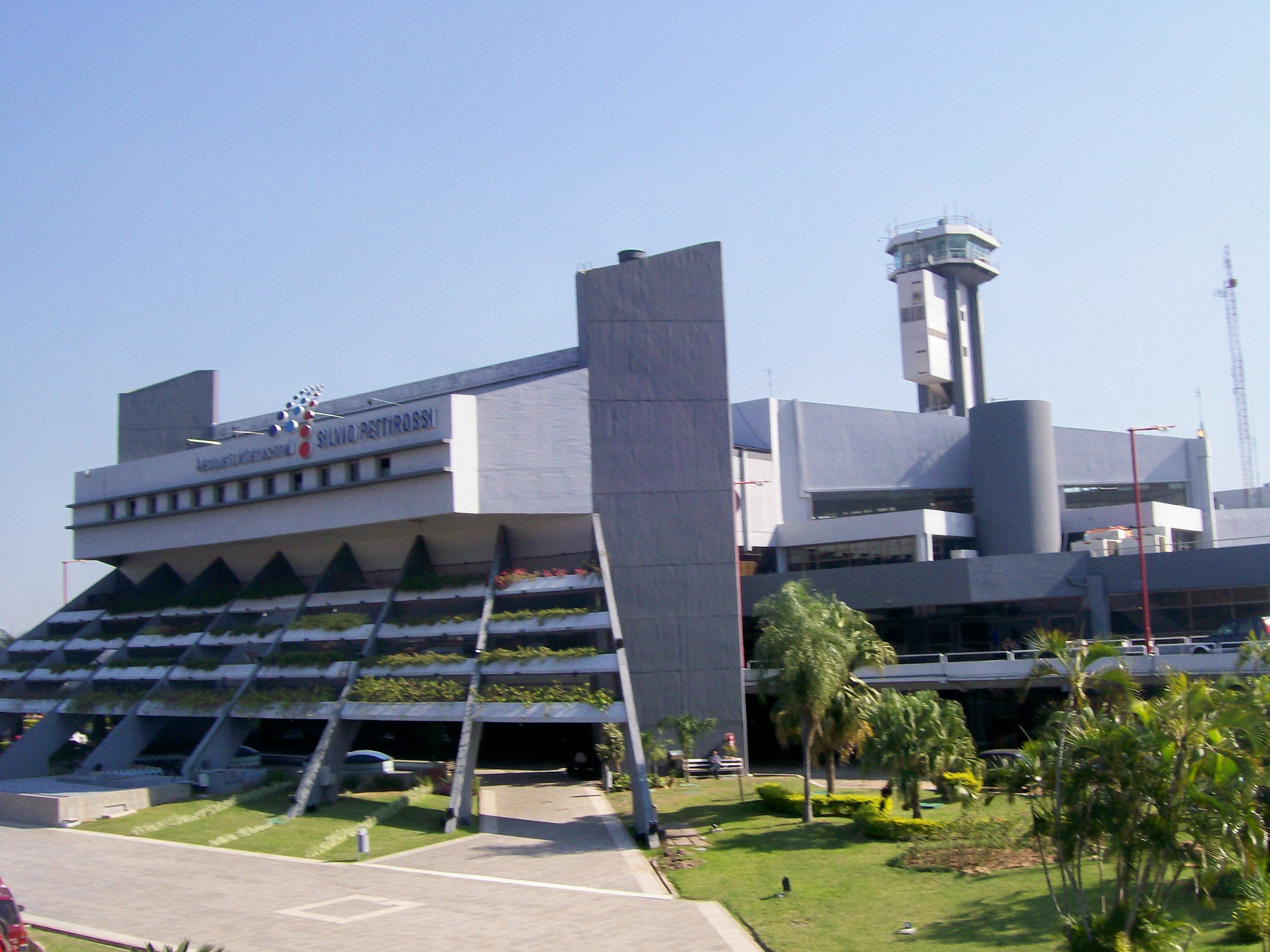|
Capiatá
Capiatá () is a city in Central Department, Paraguay. It is the only city in Central that borders seven cities: Aregua, Itaugua, Juan Augusto SaldĂvar, Luque, Ă‘emby, San Lorenzo and Ypane. It is the location of the Francisco LĂłpez Military Academy. Notable residents *Carlos Lara Bareiro Carlos Lara Bareiro was a Paraguayan classical musician, composer, and conductor. He was born on the March 6, 1914 to Juan Carlos Lara Castro and Lorenza Bareiro in Capiatá, Paraguay. He inherited the aptitude and vocation for music from his fath ..., musician * Isidro Prieto, boxer Populated places in the Central Department Populated places established in 1728 1728 establishments in the Spanish Empire {{Paraguay-geo-stub ... [...More Info...] [...Related Items...] OR: [Wikipedia] [Google] [Baidu] |
Central Department
Central () is a department in Paraguay. The capital is Areguá. With 2,243,792 inhabitants, it is the most populated and the smallest of the 17 departments of Paraguay. Boundaries *North: the departments of Cordillera and Presidente Hayes *West: the Argentine province of Formosa separated by the Paraguay River, and the capital district, Asunción. *East: the department of Paraguarà *South: the department of Ñeembucú Districts The department is divided in 19 districts: Geography The mountainous area of Altos and the bodies of water such as the Paraguay and the Salado rivers, the lakes Ypacaraà and Ypoá, and the pond Cabral are part of the natural limits in Central. These along with other regions in the south section generate a good potential of resources for the diverse activities such as tourism and even agriculture. Education Paraguay’s Central Department (a “department” is similar to a state or province in other countries) enjoys one of the nation†... [...More Info...] [...Related Items...] OR: [Wikipedia] [Google] [Baidu] |
Francisco LĂłpez Military Academy
The Francisco López Military Academy (officially, the ''Marshal Francisco Solano López Military Academy''; Spanish: ''Academia Militar Mariscal Francisco Solano López'') is a service academy in Capiatá, Paraguay. History The school was established in 1915 and was renamed in honor of Francisco Solano López in 1948 as the Marshal Francisco Solano López Military College. During the 1954 Paraguayan coup d'etat, President Federico Chávez initially sought refuge at the college, however, was arrested by its then-director, Marcial Samaniego. In 1995 it was redesignated the Marshal Francisco Solano López Military Academy and, in 2002, women were admitted for the first time. Organization The Francisco López Military Academy is a tri-service school responsible for training and commissioning officers of the Paraguayan Army, Navy, and Air Force. Admission to the academy is competitive; in 2012 there were 312 applicants for 110 spaces. Candidates are evaluated on a series of physic ... [...More Info...] [...Related Items...] OR: [Wikipedia] [Google] [Baidu] |
Carlos Lara Bareiro
Carlos Lara Bareiro was a Paraguayan classical musician, composer, and conductor. He was born on the March 6, 1914 to Juan Carlos Lara Castro and Lorenza Bareiro in Capiatá, Paraguay. He inherited the aptitude and vocation for music from his father and learned the basics of this art which he would then dominate. Childhood and youth He began his studies in the Battalion musician's band of the Boys Scouts. From 1932, he studied in the capital police musician's band and in the Paraguayan ateneo, with Remberto Giménez. Career Between the years 1940 and 1943 Lara Bareiro was the president of the Paraguayan association of musicians and in 1943 he got a scholarship from Brasil to study in the University of the National School Music in Rio the Janeiro where he stayed for eight years. He studied harmony, counterpoint and fuga with Newton Padua, José Paula da Silva and Virginia Fiuzza, composition with Joao Ottaviano and violin with Francisco Chiafitelli. He also received ... [...More Info...] [...Related Items...] OR: [Wikipedia] [Google] [Baidu] |
Paraguay
Paraguay (; ), officially the Republic of Paraguay ( es, RepĂşblica del Paraguay, links=no; gn, TavakuairetĂŁ Paraguái, links=si), is a landlocked country in South America. It is bordered by Argentina to the south and southwest, Brazil to the east and northeast, and Bolivia to the northwest. It has a population of seven million, nearly three million of whom live in the capital and largest city of AsunciĂłn, and its surrounding metro. Although one of only two landlocked countries in South America (Bolivia is the other), Paraguay has ports on the Paraguay and Paraná rivers that give exit to the Atlantic Ocean, through the Paraná-Paraguay Waterway. Spanish conquistadores arrived in 1524, and in 1537, they established the city of AsunciĂłn, the first capital of the Governorate of the RĂo de la Plata. During the 17th century, Paraguay was the center of Jesuit missions, where the native GuaranĂ people were converted to Christianity and introduced to European culture. ... [...More Info...] [...Related Items...] OR: [Wikipedia] [Google] [Baidu] |
Luque
Luque () is a city in Central Department of Paraguay, part of the Gran AsunciĂłn metropolitan area. Both 1635 and 1750 have been recorded as dates of its founding. It was temporarily the capital of Paraguay in 1868 during the Paraguayan War before relocation to San Estanislao. It is located at around . Luque is one of the most important cities in the country. The city counts as home of Paraguay's main international airport, Silvio Pettirossi International Airport and the Ă‘u GuasĂş Park, which is where the Paraguayan Olympic Committee is also located. The continental governing body of association football in South America, CONMEBOL, has its headquarters approximately 3 minutes from the Airport, consisting of the South American Football Museum and walking distance from the Bourbon CONMEBOL AsunciĂłn Convention Hotel. When it existed, ARPA – AerolĂneas Paraguayas had its headquarters in the ARPA Terminal on the grounds of the airport. It is a center of production of Guita ... [...More Info...] [...Related Items...] OR: [Wikipedia] [Google] [Baidu] |
San Lorenzo, Paraguay
San Lorenzo () is a city in the Central Department in Paraguay. It is a suburb of AsunciĂłn, and the third most populous city in Paraguay, with a population of 252,561. The National University of AsunciĂłn campus is located in San Lorenzo, that's why it is sometimes known as "Ciudad Universitaria" (University City). The city is the seat of the Roman Catholic Diocese of San Lorenzo. History San Lorenzo was originally a Jesuit ranch dedicated to the exploitations of plantations known as Ă‘u GuazĂş, which was erected in the 17th century. In 1767 the Jesuits were expelled from the country, and a town was established on August 10, 1775, by Captain AgustĂn Fernando de Pinedo. Location San Lorenzo is located in the Central Department of Paraguay, about 9km from the capital of the country. It is a part of Gran AsunciĂłn. It borders the cities of Luque to the north, Ă‘emby to the south, Fernando de la Mora to the west, and Capiatá to the east. *Altitude: 126 meters. *Latitude: 25 ... [...More Info...] [...Related Items...] OR: [Wikipedia] [Google] [Baidu] |
Köppen Climate Classification
The Köppen climate classification is one of the most widely used climate classification systems. It was first published by German-Russian climatologist Wladimir Köppen (1846–1940) in 1884, with several later modifications by Köppen, notably in 1918 and 1936. Later, the climatologist Rudolf Geiger (1894–1981) introduced some changes to the classification system, which is thus sometimes called the Köppen–Geiger climate classification system. The Köppen climate classification divides climates into five main climate groups, with each group being divided based on seasonal precipitation and temperature patterns. The five main groups are ''A'' (tropical), ''B'' (arid), ''C'' (temperate), ''D'' (continental), and ''E'' (polar). Each group and subgroup is represented by a letter. All climates are assigned a main group (the first letter). All climates except for those in the ''E'' group are assigned a seasonal precipitation subgroup (the second letter). For example, ''Af'' indi ... [...More Info...] [...Related Items...] OR: [Wikipedia] [Google] [Baidu] |
Humid Subtropical Climate
A humid subtropical climate is a zone of climate characterized by hot and humid summers, and cool to mild winters. These climates normally lie on the southeast side of all continents (except Antarctica), generally between latitudes 25° and 40° and are located poleward from adjacent tropical climates. It is also known as warm temperate climate in some climate classifications. Under the Köppen climate classification, ''Cfa'' and ''Cwa'' climates are either described as humid subtropical climates or warm temperate climates. This climate features mean temperature in the coldest month between (or ) and and mean temperature in the warmest month or higher. However, while some climatologists have opted to describe this climate type as a "humid subtropical climate", Köppen himself never used this term. The humid subtropical climate classification was officially created under the Trewartha climate classification. In this classification, climates are termed humid subtropical when th ... [...More Info...] [...Related Items...] OR: [Wikipedia] [Google] [Baidu] |
Juan Augusto SaldĂvar
''Juan'' is a given name, the Spanish and Manx versions of ''John''. It is very common in Spain and in other Spanish-speaking communities around the world and in the Philippines, and also (pronounced differently) in the Isle of Man. In Spanish, the diminutive form (equivalent to ''Johnny'') is , with feminine form (comparable to ''Jane'', ''Joan'', or ''Joanna'') , and feminine diminutive (equivalent to ''Janet'', ''Janey'', ''Joanie'', etc.). Chinese terms * ( or 娟, 隽) 'beautiful, graceful' is a common given name for Chinese women. * () The Chinese character 卷, which in Mandarin is almost homophonic with the characters for the female name, is a division of a traditional Chinese manuscript or book and can be translated as 'fascicle', 'scroll', 'chapter', or 'volume'. Notable people * Juan (footballer, born 1979), Brazilian footballer * Juan (footballer, born 1982), Brazilian footballer * Juan (footballer, born March 2002), Brazilian footballer * Juan (footballer, b ... [...More Info...] [...Related Items...] OR: [Wikipedia] [Google] [Baidu] |
Ă‘emby
Ă‘emby () is a city in the Central Department of Paraguay. It is part of the Gran AsunciĂłn metropolitan area. History Among the historical sites of this city stands the Church of San Lorenzo which was founded by Spanish settlers in 1718 when Ă‘emby was a population of 2,187 inhabitants; historical sites also include the ''Colegio Nacional Pablo Patricio Bogarin'' and ''Escuela Carlos Antonio LĂłpez'' both located in the center of the city. Its first mayor (''intendente'') was Pedro Regalado BogarĂn. The first democratically elected mayor was Enrique Hugo Garcia Delvalle, on December 17, 1991. In November 10, 2013 at 22:10 ( UTC-3), Lializ Velázquez is a murdered by motorcycle jets in CompañĂa Cañada District Symbols The district flag has the same dimensions as the national flag. It has two colors: deep ruby and white. The deep ruby represents the layer of Saint Lawrence, patron of the city and the color white represent peace. Both stripes have the same dimensions. The d ... [...More Info...] [...Related Items...] OR: [Wikipedia] [Google] [Baidu] |



